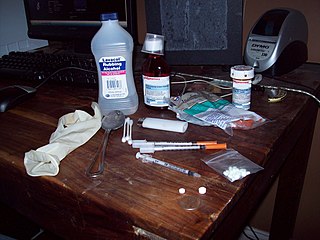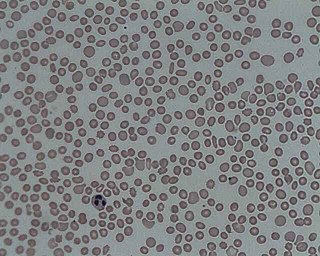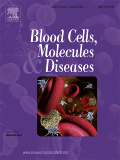Hematology is the branch of medicine concerned with the study of the cause, prognosis, treatment, and prevention of diseases related to blood. It involves treating diseases that affect the production of blood and its components, such as blood cells, hemoglobin, blood proteins, bone marrow, platelets, blood vessels, spleen, and the mechanism of coagulation. Such diseases might include hemophilia, sickle cell anemia, blood clots (thrombus), other bleeding disorders, and blood cancers such as leukemia, multiple myeloma, and lymphoma. The laboratory analysis of blood is frequently performed by a medical technologist or medical laboratory scientist.

Anemia or anaemia is a blood disorder in which the blood has a reduced ability to carry oxygen. This can be due to a lower than normal number of red blood cells, a reduction in the amount of hemoglobin available for oxygen transport, or abnormalities in hemoglobin that impair its function.
Transfusion medicine is the branch of medicine that encompasses all aspects of the transfusion of blood and blood components including aspects related to hemovigilance. It includes issues of blood donation, immunohematology and other laboratory testing for transfusion-transmitted diseases, management and monitoring of clinical transfusion practices, patient blood management, therapeutic apheresis, stem cell collections, cellular therapy, and coagulation. Laboratory management and understanding of state and federal regulations related to blood products are also a large part of the field.

Thalassemias are inherited blood disorders that result in abnormal hemoglobin. Symptoms depend on the type of thalassemia and can vary from none to severe. Often there is mild to severe anemia as thalassemia can affect the production of red blood cells and also affect how long the red blood cells live. Symptoms of anemia include feeling tired and having pale skin. Other symptoms of thalassemia include bone problems, an enlarged spleen, yellowish skin, pulmonary hypertension, and dark urine. Slow growth may occur in children. Symptoms and presentations of thalassemia can change over time. Thalassemia is also known as Cooley's anemia or Mediterranean anemia.

A blood-borne disease is a disease that can be spread through contamination by blood and other body fluids. Blood can contain pathogens of various types, chief among which are microorganisms, like bacteria and parasites, and non-living infectious agents such as viruses. Three blood-borne pathogens in particular, all viruses, are cited as of primary concern to health workers by the CDC-NIOSH: HIV, hepatitis B (HVB), & hepatitis C (HVC).

The hematocrit, also known by several other names, is the volume percentage (vol%) of red blood cells (RBCs) in blood, measured as part of a blood test. The measurement depends on the number and size of red blood cells. It is normally 40.7–50.3% for males and 36.1–44.3% for females. It is a part of a person's complete blood count results, along with hemoglobin concentration, white blood cell count and platelet count.

In hematology, thrombocytopenia is a condition characterized by abnormally low levels of platelets in the blood. Low levels of platelets in turn may lead to prolonged or excessive bleeding. It is the most common coagulation disorder among intensive care patients and is seen in a fifth of medical patients and a third of surgical patients.
The direct and indirect Coombs tests, also known as antiglobulin test (AGT), are blood tests used in immunohematology. The direct Coombs test detects antibodies that are stuck to the surface of the red blood cells. Since these antibodies sometimes destroy red blood cells they can cause anemia; this test can help clarify the condition. The indirect Coombs test detects antibodies that are floating freely in the blood. These antibodies could act against certain red blood cells; the test can be carried out to diagnose reactions to a blood transfusion.
Leukoreduction is the removal of white blood cells from the blood or blood components supplied for blood transfusion. After the removal of the leukocytes, the blood product is said to be leukoreduced.

Blood is a peer-reviewed medical journal published by the American Society of Hematology. It was established by William Dameshek in 1946. The journal changed from semimonthly to weekly publication at the start of 2009. It covers clinical and basic research in all areas of hematology, including disorders of leukocytes, both benign and malignant, erythrocytes, platelets, hemostatic mechanisms, vascular biology, immunology, and hematologic oncology.
Transfusion-associated graft-versus-host disease (TA-GvHD) is a rare complication of blood transfusion, in which the immunologically competent donor T lymphocytes mount an immune response against the recipient's lymphoid tissue. These donor lymphocytes engraft, recognize recipient cells as foreign and mount an immune response against recipient tissues. Donor lymphocytes are usually identified as foreign and destroyed by the recipient's immune system. However, in situations where the recipient is severely immunocompromised, or when the donor and recipient HLA type is similar, the recipient's immune system is not able to destroy the donor lymphocytes. This can result in transfusion associated graft-versus-host disease. This is in contrast with organ/tissue transplant associated GvHD, where matching HLA reduces the incident of the complication.

Immunohematology is a branch of hematology and transfusion medicine which studies antigen-antibody reactions and analogous phenomena as they relate to the pathogenesis and clinical manifestations of blood disorders. A person employed in this field is referred to as an immunohematologist or colloquially as a blood banker. Their day-to-day duties include blood typing, cross-matching and antibody identification.

In transfusion medicine, transfusion-associated circulatory overload is a transfusion reaction resulting in signs or symptoms of excess fluid in the circulatory system (hypervolemia) within 12 hours after transfusion. The symptoms of TACO can include shortness of breath (dyspnea), low blood oxygen levels (hypoxemia), leg swelling, high blood pressure (hypertension), and a high heart rate (tachycardia).

American Journal of Hematology is an academic journal devoted to the coverage of blood diseases. It has been published since 1976. The editor-in-chief is Carlo Brugnara. According to the Journal Citation Reports, the journal has a 2022 impact factor of 12.8, ranking it 7th out of 76 journals in the category "Hematology".
The British Journal of Haematology is a peer-reviewed medical journal focusing on hematology and other blood-related topics, such as blood diseases and their treatment. It is published by [Wiley] on behalf of the British Society for Haematology.

Blood Cells, Molecules and Diseases is a peer-reviewed medical journal covering hematology. It was established in 1975 as Blood Cells and obtained its current title in 1995. The editor-in-chief is Mohandus Narla. It is published eight times per year by Elsevier.
Pediatric Blood & Cancer is a peer-review online-only medical journal covering pediatric oncology and hematology. It was established in 1975 as Medical and Pediatric Oncology, obtaining its current name in 2004. Starting in January 2014, it stopped publishing its print edition and moved to an exclusively online format. The editor-in-chief is Peter E. Newburger. According to the Journal Citation Reports, the journal has a 2021 impact factor of 3.838, ranking it 30th out of 130 journals in the category "Pediatrics", 39th out of 78 journals in the category "Hematology", and 141st out of 245 journals in the category "Oncology".
An allergic transfusion reaction is when a blood transfusion results in allergic reaction. It is among the most common transfusion reactions to occur. Reported rates depend on the degree of active surveillance versus passing reporting to the blood bank. Overall, they are estimated to complicate up to 3% of all transfusions. The incidence of allergic transfusion reactions is associated with the amount of plasma in the product. More than 90% of these reactions occur during transfusion.
A granulocyte transfusion is a medical procedure in which granulocytes are infused into a person's blood. Granulocyte transfusions were historically used to prevent and treat infections in people with neutropenia, but the practice declined in popularity in the 1980s. Interest in the procedure increased in the 1990s due to the development of more effective methods for harvesting granulocytes and a growing population of people with severe neutropenia from chemotherapy. However, the treatment's efficacy remains poorly understood and its use is controversial.

Musa Mirmammad oglu Abdullayev was a prominent Azerbaijani hematologist, doctor of medicine, professor, and philologist-translator. He was one of the eight members of the anti-Soviet nationalist student-youth political organization "Lightning" (İldırım), formed for the independence of Azerbaijan within 1942–1944.










